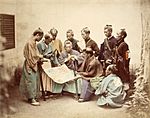Sengoku period facts for kids
 |
|---|
|
The Sengoku period (pronounced Sen-goh-koo) was a time in Japanese history when the country was often at war. It means "Warring States period" in Japanese. This period lasted for about 150 years, from the middle of the 15th century to the end of the 16th century. During this time, there was not much peace or order in Japan.
The name "Sengoku" was chosen by Japanese historians. It is similar to a time of war in Chinese history, also called the Warring States period. After the Sengoku period, Japan finally became one united country. This also marked the end of Japan's medieval (or middle ages) period.
Contents
What Was the Sengoku Period?
The Sengoku period was a time of great change and conflict in Japan. Many powerful leaders, called daimyo, fought each other for control of the land. These battles happened all over Japan. It was a time when old ways of ruling were breaking down. New leaders tried to gain power and unite the country under their rule.
Why Did the Wars Start?
Before the Sengoku period, Japan had a central government. However, this government became weak. Local lords, or daimyo, started to become very powerful in their own areas. They built up their armies and began to fight their neighbors. Everyone wanted more land and more power. This led to many small wars that eventually spread across the whole country.
Life During the Sengoku Period
Life for ordinary people during this time was often hard. Wars could break out anywhere. Farmers and villagers sometimes had to join armies or protect their homes. New castles were built for defense. New weapons, like firearms, also became more common. Despite the fighting, new ideas and ways of doing things also appeared.
Important Leaders of the Sengoku Period
Three very important leaders helped to end the Sengoku period. They worked to bring Japan together as one nation. These leaders were Oda Nobunaga, Toyotomi Hideyoshi, and Tokugawa Ieyasu. They are often called the "Three Great Unifiers" of Japan.
Oda Nobunaga: The First Unifier
Oda Nobunaga was a strong and fearless daimyo. He was the first to start the process of uniting Japan. He was known for being very smart in battle. He also used new weapons like guns effectively. Nobunaga conquered many lands and defeated many enemies. Sadly, he was betrayed and died before he could finish uniting Japan.
Toyotomi Hideyoshi: From Farmer to Ruler
Toyotomi Hideyoshi was one of Nobunaga's best generals. He came from a humble family, not a noble one. After Nobunaga's death, Hideyoshi took over his mission. He continued to unite Japan through both fighting and peaceful agreements. Hideyoshi became a very powerful ruler. He made many changes to how Japan was governed.
Tokugawa Ieyasu: The Last Unifier
Tokugawa Ieyasu was another powerful daimyo and a friend of Nobunaga. After Hideyoshi died, Ieyasu became the most powerful leader. He won a very important battle called the Battle of Sekigahara. This victory allowed him to finally unite all of Japan. Ieyasu then started a new government called the Tokugawa Shogunate. This government ruled Japan peacefully for over 250 years.
Other Key Figures
Besides the three great unifiers, other important leaders played a role. Date Masamune was a famous daimyo from northern Japan. He was known as the "One-Eyed Dragon." Akechi Mitsuhide was a general who betrayed Oda Nobunaga. His actions changed the course of history.
How the Sengoku Period Ended
The Sengoku period ended when Japan was finally united under one strong government. This was mainly thanks to the efforts of Oda Nobunaga, Toyotomi Hideyoshi, and Tokugawa Ieyasu. Tokugawa Ieyasu's victory at the Battle of Sekigahara in 1600 was the final step. After this, Japan entered a long period of peace and stability. This new era was called the Edo period.
Related pages
Images for kids
-
A gun workman from Sakai, a city in Osaka, Japan.
See also
 In Spanish: Período Sengoku para niños
In Spanish: Período Sengoku para niños


